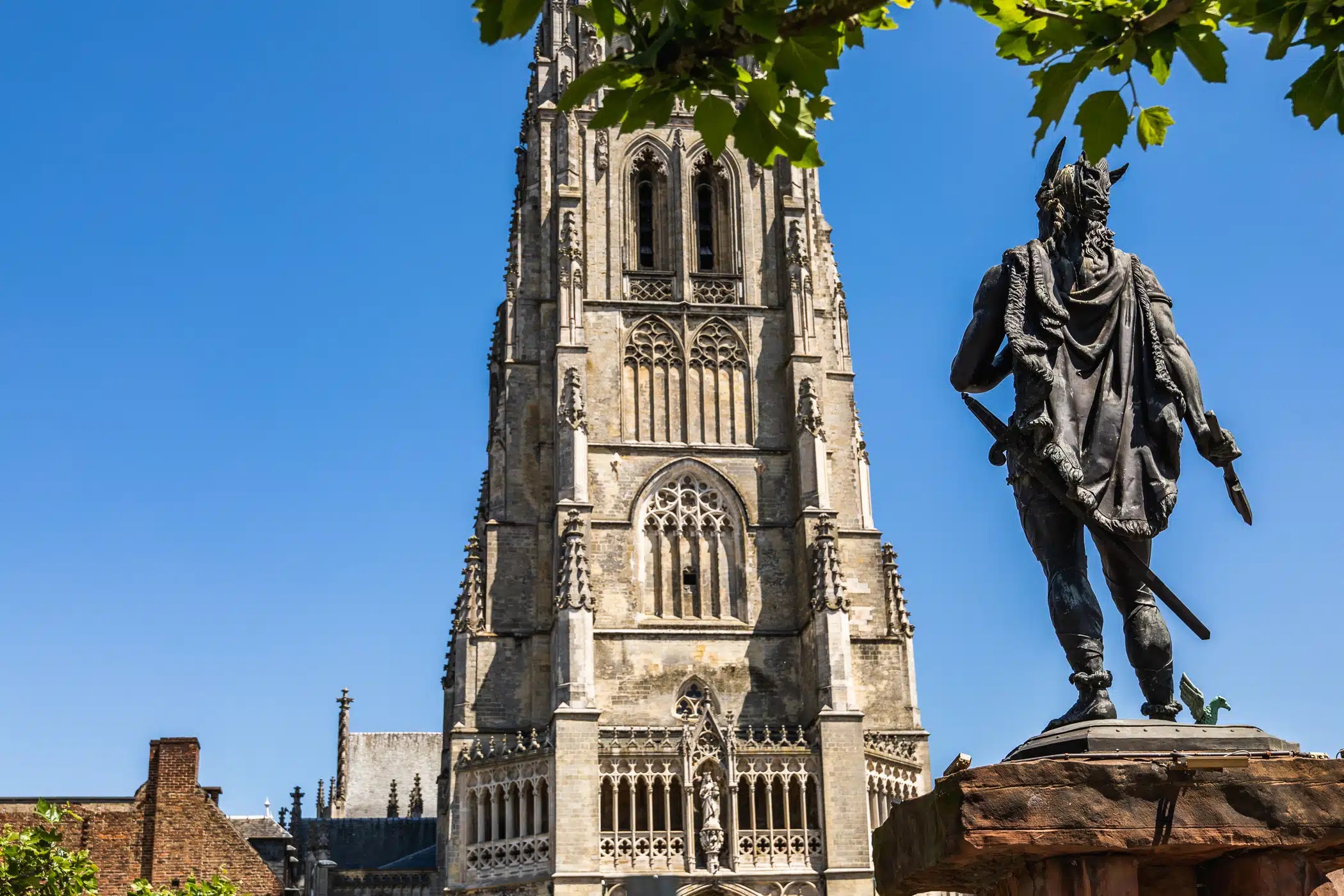In the 2nd century, a walled city called Atuatuca Tungrorum grew under Roman rule into one of the largest trading cities in Northern Gaul. Its importance diminished after the fall of the Roman Empire in the 5th century, but Tongeren re-emerged as a significant town in the 13th century with a new city wall, beguinage, cloisters and churches.
It was a favourite stop for pilgrims en route to the Santiago de Compostela, who would spend the night in Sint-Jacobusgasthuis (St Jacob’s Guest House) in the town centre. (Later this guest house was turned into a hospital, orphanage, rest home, municipal service centre and finally, a hotel, residential and shopping complex.)
In 1677, Louis XIV’s invading troops sparked a huge blaze, known as the ‘Great Fire’, and reduced much of Tongeren to ashes, almost wiping it off the map. But after Belgian independence in 1830, the old city was rejuvenated.
Today, Visit Tongeren claims the city – which sits about 50 km equidistant from Hasselt, Liège and Maastricht – embraces the enterprising spirit of the Romans. Tongeren native Robert Cailliau, who helped set up the World Wide Web, would likely agree.
Roman relics
The Gallo-Roman Museum tells the story of people in Limburg from prehistory to the late Roman period in about 2,000 artefacts plus lifelike models, animations and films. It also has temporary exhibitions, such as the Antiquity in Colour, running until June 2, 2024, which shows that white marble statues popularised during the Renaissance were painted in bright colours by the ancient Greeks and Romans.
German archaeologists Vinzenz Brinkmann and Ulrike Koch-Brinkmann display dozens of full-size reconstructions of colourful statues made with historic techniques.
Parts of the Roman flint stone city wall, built around Atuatuca Tungrorum as a status symbol rather than for defence, are still intact. A tourist heritage walk called the Milestone Route goes past the best-preserved parts on Legioenenlaan and Caesarlaan (where a 1st century Roman temple can also be found).
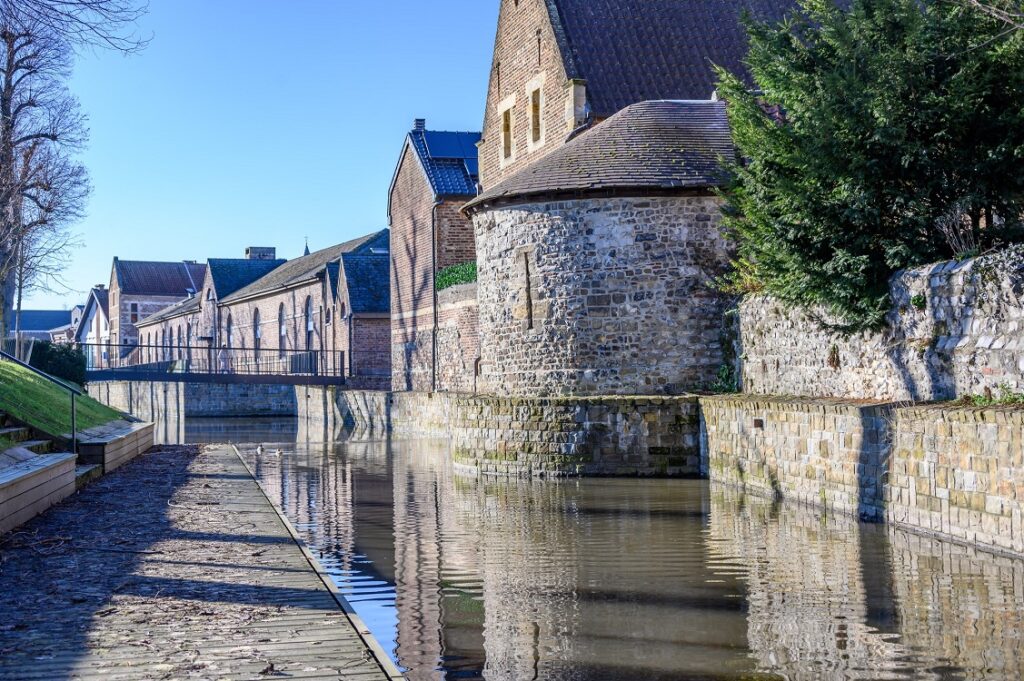
The old Roman walls
Near the city centre are the ruins of Beukenberg, a Roman aqueduct with an artificial embankment that once contained wooden water basins to provide Tongeren with drinking water. It is the largest archaeological monument in Belgium and an intriguing place for walking (a map is available from Visit Tongeren).
Just outside the city centre in the borough of Lauw are several Gallo-Roman burial mounds known as tumuli. One dates to the 1st to 3rd century.
Medieval marvels
Remains of a 13th century defensive wall surround Tongeren, with the best-preserved pieces near Leopoldwal and Elfde Novemberwal. During the Middle Ages, it had six gates and 13 towers over 54 hectares, with each guild responsible for maintaining and defending a tower.
Two survived: Lakenmakerstoren, the sheet makers’ tower, located along the Jeker River between Kastanjewal and Sint-Ursulastraat; and Velinxtoren at Albertwal, named after the influential Velinx family from the 16th century.
Of the six original gates, only Moerenpoort (Moeren Gate) from 1379 still stands. Its name refers to surrounding marshes and it was built on the ruins of the 2nd century Roman wall. Inside is a museum about local military history with a great view of the city centre and beguinage.
The original Stadhuis (City Hall) on the Market Square was burned in the Great Fire but rebuilt in the 18th century with a striking red façade. It is a copy of Liège’s city hall: it was designed by the same architect, Pascal Barbier of Liège. Guided tours are available about its torrid history.
Religious rites
The 13th century Basilica of Our Lady on the Market Square is considered one of the most beautiful Gothic churches in Belgium. It includes the Teseum with three museums in one: an archaeological site, treasury and belfry. The archaeological site underground has ruins of defensive walls and the story of religious people in the area.
The treasury includes Flemish masterpieces and relics of saints. The bell tower, with 49 carillon bells, is one of the 56 Belgian and French belfries recognised as UNESCO World Heritage Sites. Visitors can climb to the top. The church also has two Gothic chapels, a courtyard, a monastery garden and a cloister.
The Beguinhof van Tongeren, also a UNESCO World Heritage Site, was the residence of beguines – unmarried, religious women – from the 13th to 18th centuries. At its peak, the beguinage had 300 beguines living in 100 houses. But in 1798, French revolutionaries took it over for public use. Its Beghina museum, complemented by a tour guide dressed as a beguine, explains the women’s way of life.
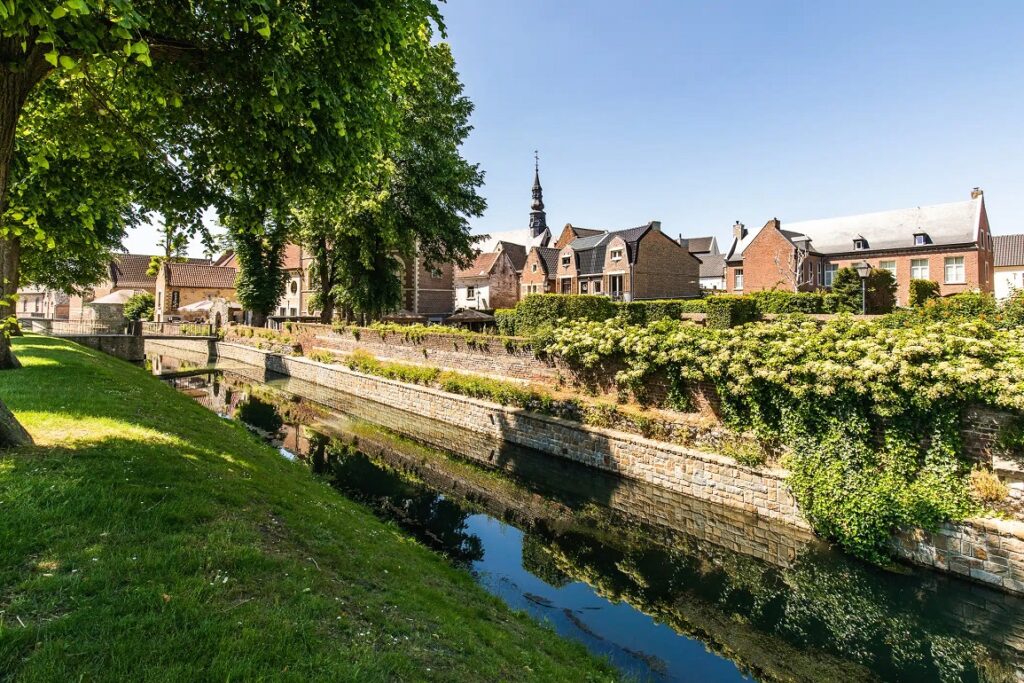
Beguinhof von Tongeren
The tour ends in the museum’s cellar with a tasting of craft beguine beer or elderflower lemonade. A Tongeren City Pass (€15) includes access to the Beghina, two of three parts of one’s choice in the Teseum, the permanent or temporary exhibition in the Gallo-Roman Museum and Moerenpoort as well as dining deals.
Gasthuiskapel (Guest House Chapel), part of the former St Jacob’s Guest House, is a fitting home for Visit Tongeren, which includes a small museum about the building’s history, interactive touch screen about Tongeren’s history and shop with local products.
Antiques and contemporary art
The Tongeren Antique Market is the largest of its kind in the Benelux. It occurs every Sunday year-round and features international antiques and vintage goods. Around 40 antique shops and 350 exhibitors display everything from old postcards and vinyl records to crystal, silver, pottery and handmade furniture.
Since 2012, the 9th Month art project has installed contemporary artwork in Tongeren’s city centre every two years. To date, there are eight installations at Museumkwartier, Sint-Catharinastraat, Museumplein, Cultureel Centrum De Velinx, Pliniuspark and Stadhuisplein. Tongeren also has 10 art galleries, one of which is in a former church of the beguinage (Sint-Ursulakapel).
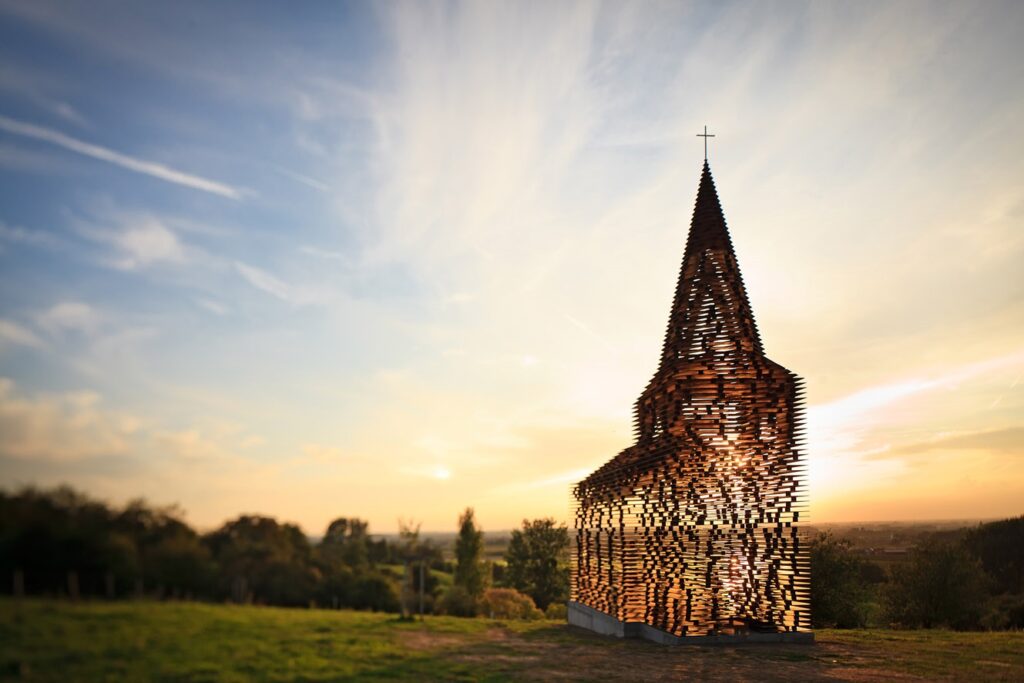
Reading between the lines, a see-through church
In the neighbouring village Borgloon there are six striking outdoor installations known as PIT art in the open air. The most famous is Reading Between the Lines, a see-through church made of stacked steel plates designed by Gijs Van Vaerenbergh.
Limburgers, known for ‘singing’ Dutch, arguably add to the cultural landscape.
Regional eats and drinks
It might be a stretch to call the orchard-rich Haspengouw region near Tongeren the ‘’, as local tourist officials do. But growers there harvest abundant fruit: apples, pears, strawberries, cherries, raspberries, blackberries, wine grapes as well as sugar beets and grains. Blossoming fruit trees in April and May make beautiful landscapes for biking and hiking.
The Romans first introduced fruit trees and vineyards in the Haspengouw, where cultivation increased in the 18th and 19th centuries. A former railway line known as the ‘fruit track’ fostered trade, making the Haspengouw the second-largest fruit region of Europe.
Many Tongeren shops sell products made from local agricultural products, such as syrups, jams, Limburg fruit pie and Tongeren sugar pie. Stroop Fabriek Fruit Experience Center in Borgloon, which boasts of being, offers a Loonse stroop factory tour. The Bleus family factory, dating to 1843, in the village of Wellen also produces syrups.
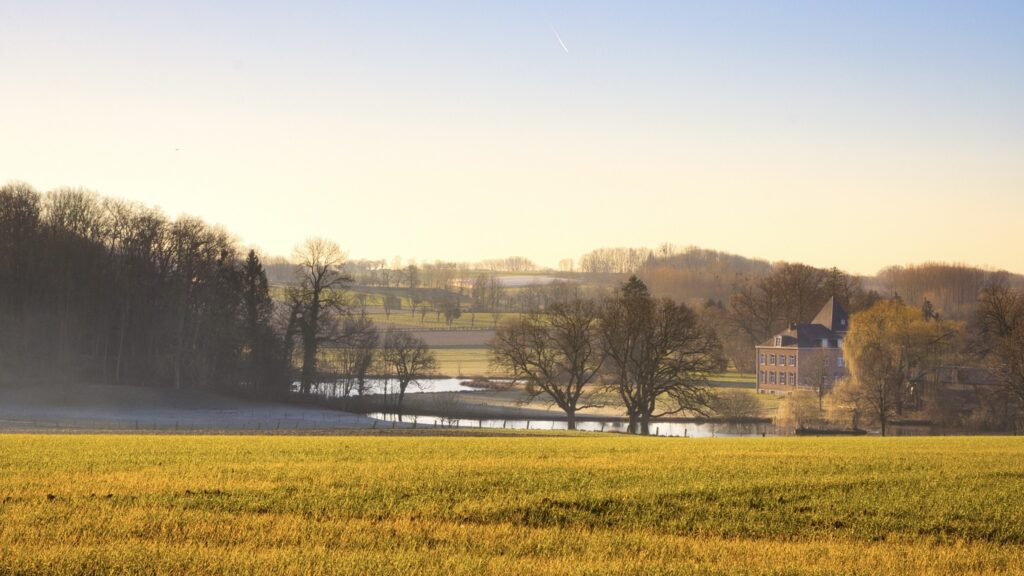
The Borgloon fields
Ruttermolen bed and breakfast, located in a 1360 water mill on the Jeker River, produces a range of jams, including exotic quince-speculoos and strawberry-balsamic vinegar, as well as artisanal products like marzipan, hazelnut paste, ice cream, limoncello, beer and advocaat (an eggy alcoholic drink).
Of course, fruit attracts bees so there is plenty of honey in the Haspengouw. Imkerij (Beekeeping) De Kevie in De Kevie nature reserve sells honey, mead (liquor made from honey) and other bee products. The first vineyards were planted in the Tongeren countryside some 2,000 years ago. Today, the Haspengouw produces many of Belgium’s wines and several Tongeren restaurants serve them.
The only wine chateau in Belgium is Genoels-Elderen in the neighbouring municipality of Riemst: privately owned by the Van Rennes family and the largest wine estate in the country with 22 hectares. Genoels-Elderen wines have won international medals and been voted Belgium's best several times. Visitors can see the vineyard, castle grounds, a rose garden, distillery, press house and 13th century wine cellars by appointment. The tour ends with a wine tasting and can be booked via Visit Tongeren.
Watercress is another agricultural commodity associated with Tongeren. The Sint-Lucie family nursery in Lauw has been growing the plant for generations. Restaurateurs often source the nutritious, small leafy greens there and a local beer is even made from watercress seeds (La Cress). The Celts used watercress 2,000 years ago to add a touch of bitterness to their brews, a tradition continued by La Cress, which has a mild mustard flavour.
Other notable local beers include 3700, named after the postal code of Tongeren, and hoppy AmBassadeur made by At Tack Brewery; amber Ambiorix by the Slaghmuylder family brewery; Ambiorocks by Amburix Craft Brewery; Hesbania from Genoelselderen-Riemst; and a range from Wilderen Brewery and Distillery in Sint-Truiden. Polygoon brewery produces light and hoppy Anna; stronger Fleur wheat beer; and strong Kamiel dark beer. Sint-Ursulastraat 7 in the beguinage still has a Brouwhuis (Beer House) from 1644, which serves Het Dagelyckx beer, an organic tripel.
AMBIORIXGIN, the “first gin of the first city,” is spiced with Gallic herbs (mugwort, blue fenugreek, nettle, wild garlic and lovage) found in the region 2,000 years ago. AMBIORIXMAS is a limited edition gin with a touch of cranberry for end-of-year celebrations. Caesaar'ke brandy was created by Tourism Tongeren and an artisanal distillery that uses barley malt and rye.
Unique treats are Tongerse Moppen (Tongeren Jokes), holiday cookies from the 18th century made with aniseed, honey and candied sugar, as well as Caëderkükske, shortbread made with coconut in the shape of a Roman dodecahedron (12 pentagonal surfaces) found in the Gallo-Roman Museum. Speculaas – differing from Belgian speculoos with fewer spices – in the shape of Ambiorix is sold by Fastré Bakery. Melocakes (chocolate-covered marshmallows on biscuits) have been made by Patisserie Blanckaert since 1902.
EXPERIENCE
Antique Market: Large indoor-outdoor flea market every Sunday from 7am until 12pm
Food Market: Features artisanal, regional products each Thursday on the Market Square from 8am to 1pm
MoMeNT: Annual contemporary cultural festival in the summer with exhibitions, performances, music, open-air films and more in various locations, moment.tongeren.be
St Evermarus: Each May 1 in the village of St Rutten, a pilgrims’ mass, horseback procession and play about the martyrdom of St Evermarus, a Frisian pilgrim murdered by robbers, Evermarus.be
Coronation of Mary: Every seven years, a re-enactment of the coronation of the Holy Virgin Mary with pontifical masses, processions and evening plays, July 2030
SAVOUR
Alter: Meaning ‘different’ in Latin as a nod to the Romans, a Michelin star restaurant in a former school featuring “creative cuisine” that lets ingredients shine
Bistro Belix: Classic Belgian kitchen incorporating regional ingredients, wines and spirits
Magis: A Michelin-star restaurant featuring Mediterranean cuisine in a renovated historical house with a terrace and garden
De Mijlpaal: Another one-star Michelin restaurant that translates as 'The Milestone’ offering international cuisine in an elegant, modern setting
Infermerie: A brasserie with “honest” food from high-quality ingredients in a historic building of the Beguinage
Le 54: Near the main square in a renovated house, a good value lunch spot with European cuisine
SIP AND SNACK
De Boulevaer: An upscale, modern brasserie featuring local products
Herberg ‘t Sweet: Meaning ‘The Sword’, an old café near the Market Square with a fireplace and local beers
Museumcafe: In the Gallo-Roman Museum, a café with breakfast and lunch
The Cremery: Near the Moerenpoort, features homemade ice cream and waffles
Le Vinobar: In the Vinotel X hotel, a wine bar with selections from various countries, including flights, and original snacks and tasting trays
STAY
B&B Atuatuca: A luxurious home with six themed rooms for up to 14 people, including breakfast and parking
Boutique Hotel Caelus VII: Meaning seventh Heaven, it offers seven rooms in a three-star renovated townhouse with personalized service
Eburon: A four-star hotel in the city centre with 52 stylish rooms in a former medieval hospital
Hotel 't Huys van Steyns: A three-star hotel in an 1892 townhouse with a shoe history that has breakfast, a garden and parking
Tree Tents: Four teardrop-shaped tents hanging from trees in the Tranendreef, April-Sept., book via VisitBorlgloon.be
Vinotel X: Modern, family-run hotel with a wine bar, afternoon tea and outdoor dining area
SHOP
Ambishop: Concept and gift store with a range of local and international products from Italian liquors to fragrances for the home
Bioboerderij Aardevot: Farm shop with all home-grown products, including eggs, beef and pork
Kijkboerderij Hoge Dries: Organic farm shop featuring home-grown vegetables
Museumshop: Shop in the Gallo-Roman Museum selling books about ancient times and unique educational gifts and souvenirs
Visit Tongeren: Sells a range of regional products, including biscuits, jams, syrups, beer and wines

